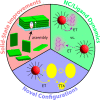A Sensitizer of Purpose: Generating Triplet Excitons with Semiconductor Nanocrystals
- PMID: 36855545
- PMCID: PMC9928406
- DOI: 10.1021/acsmaterialsau.2c00047
A Sensitizer of Purpose: Generating Triplet Excitons with Semiconductor Nanocrystals
Abstract
The process of photon upconversion promises importance for many optoelectronic applications, as it can result in higher efficiencies and more effective photon management. Upconversion via triplet-triplet annihilation (TTA) occurs at low incident powers and at high efficiencies, requirements for integration into existing optoelectronic devices. Semiconductor nanocrystals are a diverse class of triplet sensitizers with advantages over traditional molecular sensitizers such as energetic tunability and minimal energy loss during the triplet sensitization process. In this Perspective, we review current progress in semiconductor nanocrystal triplet sensitization, specifically focusing on the nanocrystal, the ligand shell which surrounds the nanocrystal, and progress in solid-state sensitization. Finally, we discuss potential areas of improvement which could result in more efficient upconversion systems sensitized by semiconductor nanocrystals. Specifically, we focus on the development of solid-state TTA upconversion systems, elucidation of the energy transfer mechanisms from nanocrystal to transmitter ligand which underpin the upconversion process and propose novel configurations of nanocrystal-sensitized systems.
© 2022 The Authors. Published by American Chemical Society.
Conflict of interest statement
The authors declare no competing financial interest.
Figures





References
-
- Trupke T.; Green M. A.; Würfel P. Improving Solar Cell Efficiencies by Up-Conversion of Sub-Band-Gap Light. J. Appl. Phys. 2002, 92 (7), 4117–4122. 10.1063/1.1505677. - DOI
-
- Schulze T. F.; Schmidt T. W. Photochemical Upconversion: Present Status and Prospects for Its Application to Solar Energy Conversion. Energy Environ. Sci. 2015, 8 (1), 103–125. 10.1039/C4EE02481H. - DOI
-
- Shockley W.; Queisser H. J. Detailed Balance Limit of Efficiency of P-n Junction Solar Cells. J. Appl. Phys. 1961, 32 (3), 510–519. 10.1063/1.1736034. - DOI
Publication types
LinkOut - more resources
Full Text Sources
